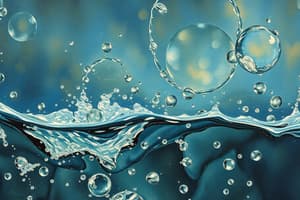Podcast
Questions and Answers
What is the simple chemical formula of water?
What is the simple chemical formula of water?
- H2O2
- O2H
- H2O (correct)
- HO
What is the reason that water has high melting and boiling points?
What is the reason that water has high melting and boiling points?
- Water is a nonpolar molecule.
- Water molecules form hydrogen bonds. (correct)
- Water has low molecular size.
- Water forms strong ionic bonds.
Why is water considered a polar solvent?
Why is water considered a polar solvent?
- It is neutral in charge.
- It has regions of positive and negative charge. (correct)
- It does not mix with ionic compounds.
- It can dissolve all types of substances.
Which of the following substances is likely to dissolve in water?
Which of the following substances is likely to dissolve in water?
What happens to water molecules as water cools to 4 °C?
What happens to water molecules as water cools to 4 °C?
How does the structure of ice compare to liquid water?
How does the structure of ice compare to liquid water?
What is a major impact of water being a good transport medium in biological systems?
What is a major impact of water being a good transport medium in biological systems?
What type of bond is primarily responsible for water molecules sticking together?
What type of bond is primarily responsible for water molecules sticking together?
Which statement about hydrogen bonds in water is accurate?
Which statement about hydrogen bonds in water is accurate?
Which biological function is significantly influenced by the properties of water?
Which biological function is significantly influenced by the properties of water?
What is the significance of water's high specific heat capacity for aquatic ecosystems?
What is the significance of water's high specific heat capacity for aquatic ecosystems?
How do the cohesive properties of water affect plant transport systems?
How do the cohesive properties of water affect plant transport systems?
What structural characteristics differentiate amylose from amylopectin?
What structural characteristics differentiate amylose from amylopectin?
Why is the ability of carbon to form four bonds essential for organic molecules?
Why is the ability of carbon to form four bonds essential for organic molecules?
Which type of carbohydrate is known for providing a quick energy source?
Which type of carbohydrate is known for providing a quick energy source?
What role do hydrogen bonds play in water's surface tension?
What role do hydrogen bonds play in water's surface tension?
What is a significant characteristic of polysaccharides as energy storage molecules?
What is a significant characteristic of polysaccharides as energy storage molecules?
Which of the following statements about carbohydrates is correct?
Which of the following statements about carbohydrates is correct?
Why is starch important for plants as an energy storage molecule?
Why is starch important for plants as an energy storage molecule?
How do the adhesive properties of water influence biological systems?
How do the adhesive properties of water influence biological systems?
Flashcards are hidden until you start studying
Study Notes
Water Molecule Structure and Properties
- The chemical formula for water is H₂O, consisting of two hydrogen atoms and one oxygen atom.
- Water is polarized, with the oxygen atom attracting electrons more strongly than hydrogen, creating a dipole.
- Hydrogen bonds form between water molecules due to the attraction between the slightly negative oxygen and the slightly positive hydrogen atoms.
- While individual hydrogen bonds are weak, their cumulative effect results in water's high melting and boiling points relative to other substances of similar molecular size.
Biological Importance of Water
- Water serves as a polar solvent, dissolving various ionic substances like sodium chloride, as well as many polar covalent compounds.
- The chemical reactions within cells predominantly occur in aqueous solutions, facilitated by water's ability to dissolve numerous substances.
- At 4°C, water reaches maximum density; as it cools further, it expands, resulting in ice being less dense than liquid water, allowing it to float and insulate water below.
- Water possesses a high specific heat capacity, absorbing and releasing heat slowly, helping to maintain stable temperatures in environments like lakes and oceans.
Water's Cohesion and Adhesion
- Water molecules exhibit strong cohesion, which is crucial for transporting water in plants from roots to leaves.
- Water is adhesive, allowing it to stick to other substances, important in processes such as plant transport and surface tension.
- High surface tension in water results from strong intermolecular forces, creating a 'skin' effect that aids various biological functions.
Organic Molecules and Carbon Bonding
- Biological molecules, primarily organic compounds, are composed of carbon, hydrogen, oxygen, and occasionally nitrogen, sulfur, and phosphorus.
- Carbon can form four bonds, enabling the creation of complex structures like rings and long chains, essential for the diversity of organic molecules.
- Carbon's ability to form polymers occurs when small molecules (monomers) bond to create large molecules, crucial for biological macromolecules.
Carbohydrates: Structure and Function
- Carbohydrates serve as a vital energy source in cells and are significant in human diets, forming part of plant cell walls.
- Common carbohydrates include sugars and starches, with the basic structure consisting of carbon, hydrogen, and oxygen.
- Three main carbohydrate types: monosaccharides (simple sugars), disaccharides (two sugars), and polysaccharides (chains of sugars).
Monosaccharides: Simple Sugars
- Monosaccharides are defined by the presence of one oxygen and two hydrogen atoms for each carbon, generally expressed by the formula (CH₂O)ₙ.
- Triose sugars (n=3) are significant in respiration, particularly in mitochondria.
Starch: Energy Storage in Plants
- Starch is crucial for energy storage in plants, converting photosynthesis products into a compact, insoluble form.
- The two components of starch are:
- Amylose: unbranched polymer of glucose, forming a spiral structure for compact storage.
- Amylopectin: branched polymer of glucose, with branching that allows rapid glucose release when needed.
- Structural differences in amylose and amylopectin are due to glycosidic bond types (1,4 for amylose and both 1,4 and 1,6 for amylopectin).
Studying That Suits You
Use AI to generate personalized quizzes and flashcards to suit your learning preferences.




